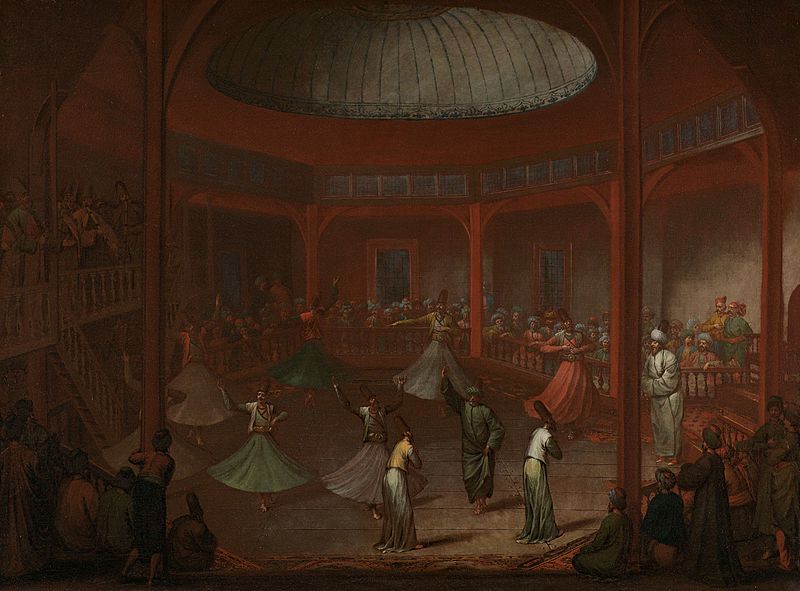Image: Dansende derwisjen Rijksmuseum SK-A-4081

Description: Derwishen of islamitische heiligmannen namen in het religieus tolerante Istanbul een bijzondere plaats in. Net als christelijke monniken zwierven sommige derwishen over het platteland of door de stad, terwijl anderen in gemeenschappen of ordes leefden. De bekenste orde is die van de Mevlevi-derwishen, de volgelingen van de filosoof en mystieke dichter Jalal ad-Din Rumi (1207-1273), die ook wel Mevlana, ‘onze meester’ wordt genoemd. Mevlevi-derwishen proberen door middel van gebed, muziek en wervelende dans in contact te komen met Allah. Hun rechterhand is bij de dans omhoog gericht om de hemelse zegen te ontvangen, die ze met de linkerhand doorgeven naar de aarde. De volgelingen van Mevlana woonden in tekkes, ook wel Mevlevihanesi genoemd. Vanmour heeft de Mevlevihane geschilderd die vlakbij het Palais de Hollande in Pera stond. Het was de oudste van de stad en bestond naast een gebedshal of danszaal (semahane), uit kamers voor de derwishen, een kamer en een speciale gebedsruimte voor hun leider de sheikh, een vrouwensectie, een bibliotheek, een eetzaal en keuken, een publieke fontein, een klokkenkamer van waaruit het gebedsuur werd aangekondigd en een begraafplaats. De ceremonie begon wanneer de leider van de derwishen zijn zetel verliet en aan de rand van de dansvloer ging staan om zijn volgelingen toe te spreken. Vanmour heeft hem rechts op het schilderij afgebeeld in de contemplatieve houding die hij gedurende de gehele ceremonie zou aannemen. Hierna groetten de derwishen hun leider één voor één, zoals de twee mannen op de voorgrond dat doen en vervolgens begonnen zij hun gebed. Door op het ritme van de muziek op dezelfde plek rondjes te draaien raakten ze in een trance. De derwishen dragen de kenmerkende cilindervormige hoed, de sikke, en lange wollen kleding die bij het ronddraaien in een mooie cirkel om hen heen zwierde.Op het balkon, dat we links boven zien, wordt fluit gespeeld. Vanmour heeft twee toeschouwers wel heel prominent afgebeeld. Zij staan achter de balustrade vlakbij de stoel van de religieus leider en hun gelaatstrekken lijken sterk op die van Patrona Halil en zijn handlanger Muslu Bese. Waarom Vanmour deze hoofdrolspelers uit de Opstand van 1730 zo prominent heeft afgebeeld is onduidelijk. Het helpt ons wel bij de datering van het schilderij, dat tot stand moet zijn gekomen tussen oktober 1730 (net na de opstand) en november 1730 (de moord op Patrona Halil en zijn medestanders). Collection: schilderijen; Vanmour serie
Title: Dansende derwisjen
Credit: http://www.rijksmuseum.nl/collectie/SK-A-4081
Author: Jean Baptiste Vanmour
Permission: This media file is in the public domain in the United States. This applies to U.S. works where the copyright has expired, often because its first publication occurred prior to January 1, 1923. See this page for further explanation. This image might not be in the public domain outside of the United States; this especially applies in the countries and areas that do not apply the rule of the shorter term for US works, such as Canada, Mainland China (not Hong Kong or Macao), Germany, Mexico, and Switzerland. The creator and year of publication are essential information and must be provided. See Wikipedia:Public domain and Wikipedia:Copyrights for more details. This work is in the public domain in its country of origin and other countries and areas where the copyright term is the author's life plus 70 years or less. You must also include a United States public domain tag to indicate why this work is in the public domain in the United States. Note that a few countries have copyright terms longer than 70 years: Mexico has 100 years, Jamaica has 95 years, Colombia has 80 years, and Guatemala and Samoa have 75 years. This image may not be in the public domain in these countries, which moreover do not implement the rule of the shorter term. Côte d'Ivoire has a general copyright term of 99 years and Honduras has 75 years, but they do implement the rule of the shorter term. Copyright may extend on works created by French who died for France in World War II (more information), Russians who served in the Eastern Front of World War II (known as the Great Patriotic War in Russia) and posthumously rehabilitated victims of Soviet repressions (more information). This file has been identified as being free of known restrictions under copyright law, including all related and neighboring rights. Data and photography rights: "All data and all images made available through the API are either in the public domain or are subject to a CC0 license." https://www.rijksmuseum.nl/en/api/terms-and-conditions-of-use This file is made available under the Creative Commons CC0 1.0 Universal Public Domain Dedication. The person who associated a work with this deed has dedicated the work to the public domain by waiving all of his or her rights to the work worldwide under copyright law, including all related and neighboring rights, to the extent allowed by law. You can copy, modify, distribute and perform the work, even for commercial purposes, all without asking permission. http://creativecommons.org/publicdomain/zero/1.0/deed.enCC0Creative Commons Zero, Public Domain Dedicationfalsefalse
Usage Terms: Public domain
License: Public domain
Attribution Required?: No
Image usage
The following page links to this image:

